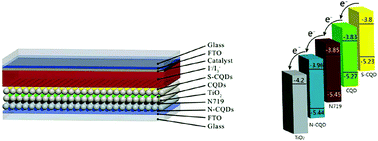High efficiency solar cells tailored using biomass-converted graded carbon quantum dots†
Abstract
The solar-to-electric conversion efficiency of mesoscopic solar cells is highly dependent on electron extraction under solar irradiation and determines the charge recombination processes within devices. Boosting charge transfer via building energy level alignment has been proved to be a promising method to enhance the output power of solar cells. In the current work, we present the successful fabrication of functional biomass-converted carbon quantum dots with graded energy levels by doping nitrogen or sulphur atoms from lotus root powder. When employed as light absorbers for mesoscopic solar cells, light harvesting and electron extraction can be markedly increased arising from the band alignment of graded carbon quantum dots, yielding maximal power conversion efficiencies of 0.158% and 0.208% for bi- and tri-cascaded photovoltaics, respectively. The primary results demonstrate that the employment of an energy-graded architecture is a promising strategy to optimize the device output. Following this line of thought, we further fabricate a co-sensitized device by integrating graded carbon quantum dots with N719 dyes to enhance the electron extraction capability. The final device yields an efficiency as high as 9.04%, showing the potential application of carbon quantum dots in high-performance solar cells.

- This article is part of the themed collection: 2019 Nanoscale HOT Article Collection


 Please wait while we load your content...
Please wait while we load your content...